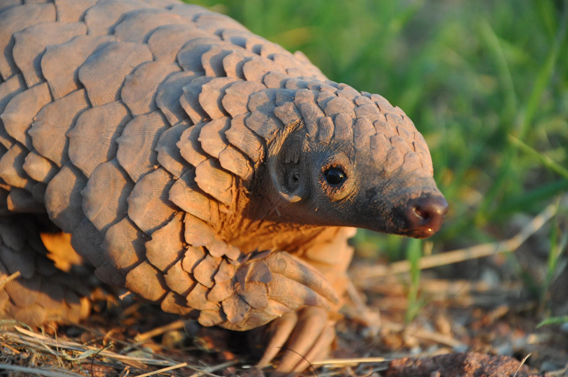- Pangolins are the world’s most trafficked animal.
- Populations of all four species of Asian pangolins are either endangered or critically endangered, mainly due to the demand for their meat and scales.
- On February 20, the fifth annual World Pangolin Day, conservation groups are trying to raise awareness about these little-known burrowing mammals to help fight their illegal trade.
Pangolins, the armor-clad mammals found in Asia and Africa, are perhaps best known for being the world’s most trafficked animal. Every year, thousands of pangolins get illegally hunted for their meat and scales, mainly to meet the demands of China and Vietnam.
Pangolin scales are made of keratin, just like human fingernails and rhino horns. And like rhino horns or tiger teeth and claws, these scales are (incorrectly) believed to have medicinal properties. Traders claim that pangolin scales can promote menstruation and lactation, and treat rheumatism and arthritis. But these claims are still unproven. Unfortunately, the scales that are meant to protect these animals have become the reason for their collapse.


There are eight living species of the pangolins today, four each in Asia and Africa. All the four Asian pangolins — Chinese pangolin (Manis pentadactyla), Sunda pangolin (Manis javanica), Indian pangolin (Manis crassicaudata), and Philippine pangolin (Manis culionensis) — are listed as either endangered or critically endangered under the IUCN Red List. On Thursday, Vietnamese officials released 16 Sunda Pangolins that had been confiscated by Forest Protection Department officers in 2015 to a “safe, undisclosed location in Vietnam,” according to Vietnam news.
The four Africa pangolin species — Cape or Temminck’s Ground pangolin (Smutsia temminckii), White-bellied or Tree pangolin (Phataginus tricuspis), Giant Ground pangolin (Smutsia gigantea), Black-bellied or Long-tailed pangolin (Phataginus tetradactyla) — are all listed as vulnerable under the IUCN Red List.
Tomorrow, February 20, is the fifth annual World Pangolin Day. On this day, conservation groups are trying to raise awareness about these little-known burrowing mammals to help fight their illegal trade.
Here are three things that you could do on this day.
Check out EIA’s interactive map to learn about the international trade in pangolins
For World Pangolin Day, the Environmental Investigation Agency (EIA) has launched an interactive map that illustrates the massive scale of pangolin trade. The map shows records of pangolin poaching and seizures from 2000 and 2015, giving details about where, when and how many pangolins were seized or poached.
“The map is intended as a regularly updated resource for use by anybody working in pangolin conservation as well as for general interest,” the EIA noted in a statement, “and is based on a subset of poaching and seizure incidents from 2000-15, compiled by EIA and derived from publicly available records, from primarily English and Chinese language sources.”

The map will also tell you if you live in a country where pangolins and their products are traded. If you do, the EIA says that you can help “by not purchasing any pangolins, pangolin derivatives or medicines containing pangolin products. And if you know of any illegal trade in pangolins, report it to the local law enforcement agency or the IUCN Species Survival Commission Pangolin Specialist Group.”
You could #pumpit4pangolins: An ice bucket-like challenge
Last year, “People for Pangolin”, a U.K.-based NGO, launched a social media campaign called #pumpit4pangolins. The campaign aims to create awareness about pangolins and helps you contribute towards pangolin conservation. This year too, the campaign wants you to roll up like pangolins, do abdominal crunches, nominate your friends, family or colleagues, and donate.
“This year we challenge you to do 20 abdominal crunches and donate £5.00 to pangolin conservation (donate here) before World Pangolin Day,” the campaign website notes. “Proceeds will be used to support on the ground pangolin conservation led by Save Vietnam’s Wildlife. Once you have completed the challenge upload the video with hashtag #pumpit4pangolins and nominate four of your friends, family or work colleagues to do the same! If you have any questions please do not hesitate to contact us and we thank you for your support of this noble cause.”
Watch some of last year’s #pumpit4pangolins videos:
Spread the word
Tell your family, friends, and colleagues about these severely threatened animals. If you need suggestions for pangolin-related resources, IUCN’s Pangolin Specialist Group’s website has information about all eight pangolin species and gives updates on what conservation groups are doing to protect these animals.
Mongabay, too, has published a number of stories on pangolin trade, rescue and conservation. You can read them here.
You could sign an online petition. Rainforest Rescue, a non-profit organization based in Germany, has an online petition that “calls on the governments of China and Vietnam to stamp out the illicit pangolin trade.”
You could also spread the word on social media.
A long-tailed #pangolin's tail can be up to 2x the length of its body! https://t.co/uylxVaYQrf #WorldPangolinDay pic.twitter.com/j25lUq8fDY
— IUCN PangolinSG (@PangolinSG) February 18, 2016
Some earlier Mongabay features on pangolins
- Happy World Pangolin Day. What are we celebrating? (02/21/2015)
- Over a million pangolins slaughtered in the last decade (07/28/2014)
- Pity the pangolin: little-known mammal most common victim of the wildlife trade (02/11/2013)
- Pangolins imperiled by internet trade–are companies responding quickly enough? (01/24/2012)


